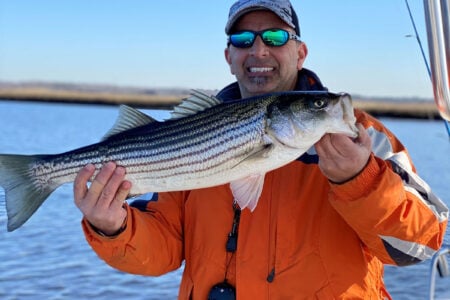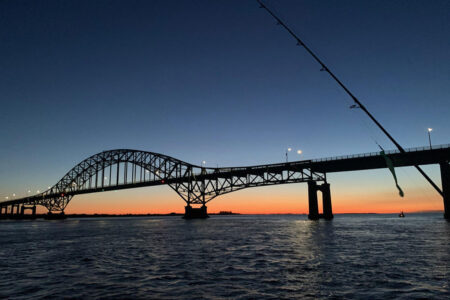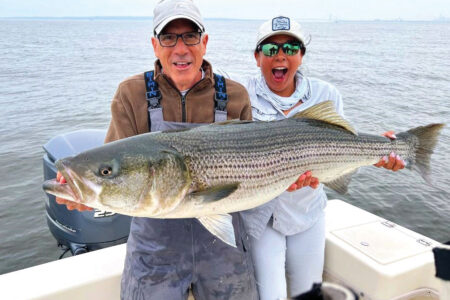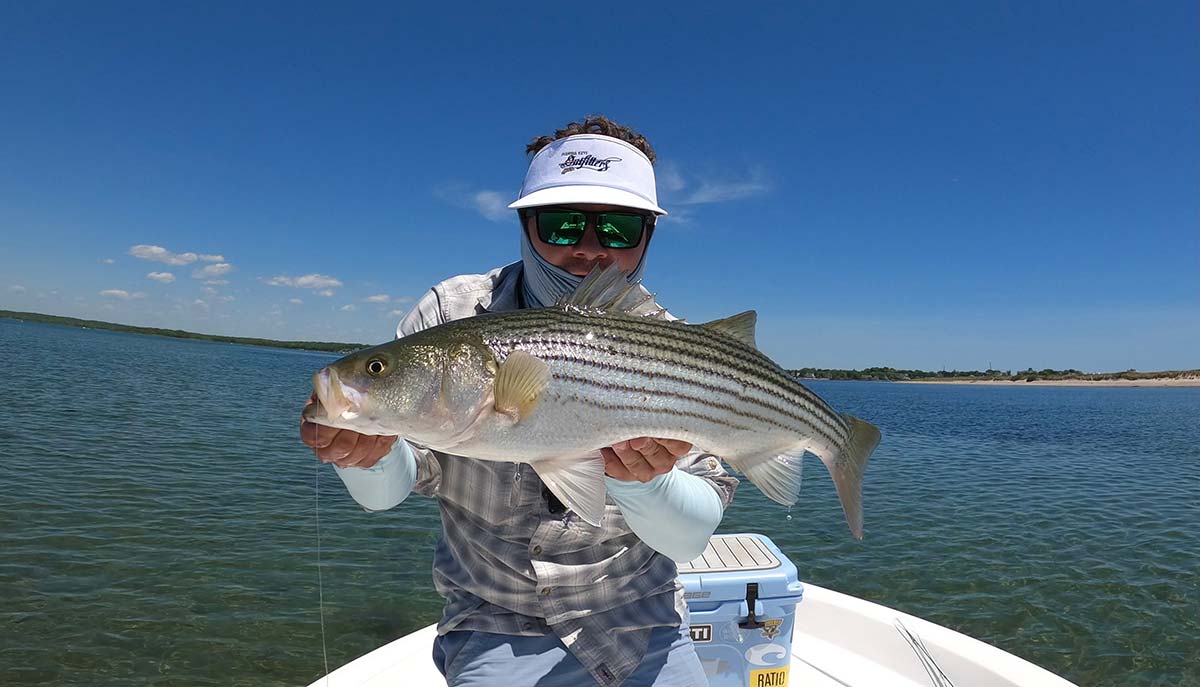
Fishing the flats, with fly or spin, in an exhilarating way to target striped bass.
Crystal clear flats and beaches can be found up and down the range of striped bass. Many of these structures provide anglers with the opportunity to sight fish for the Northeast’s most beloved saltwater species. Not only does the setting itself often harken to sand flats where species like bonefish and permit are targeted but the quirky behaviors the stripers adopt when they get into these habitats cause anglers to draw comparisons to those more tropically-centered fish.
Some of the comparisons are spot on, but there’s nothing quite like sight fishing for stripers in the northeast! The fish behave in surprising and different ways, constantly befuddling even the most observant angler. In this angler’s opinion, there’s no more engaging and exciting way to target striped bass.
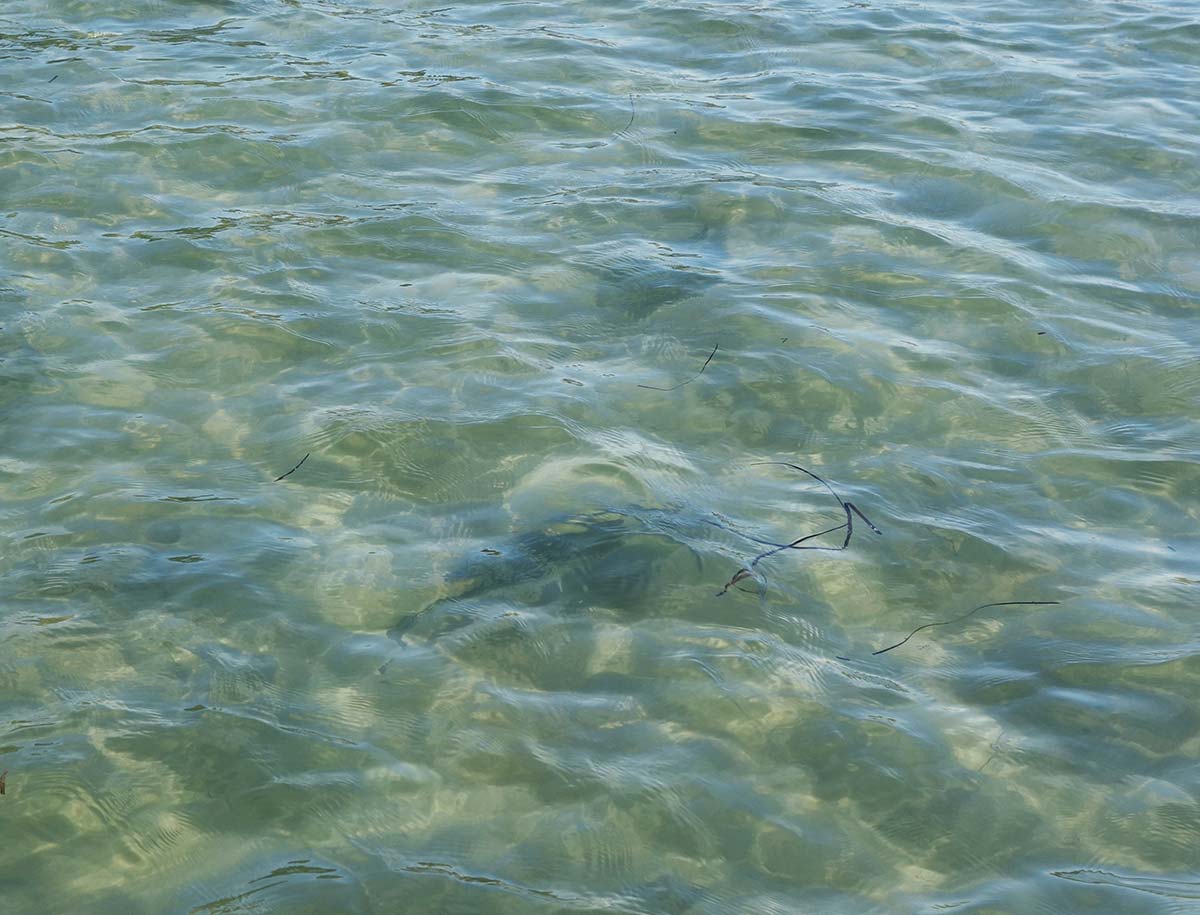
A Tropical Tactic
It’s unlikely that anyone really knows who first saw a striped bass swimming in shallow, clear water and cast a lure, fly, or bait at it to try to tempt it and watched its reaction. But we can dive into the history of sight fishing in the Northeast. The game as we know it now was largely started by Capt.Jeff Northrop, who took what he learned on the bonefish flats to his home waters in the late 70’s. Northrop spread the gospel of poling flats skiffs and sight casting to stripers with fly rods and over time others joined the movement.
Now, in my home waters in the Eastern Long Island Sound, it is no surprise to see a flats boat poling down an edge looking for targets. The game isn’t only for boats though, and for every skiff there’s a handful of dedicated anglers going at it on foot, wading shallow bars and walking beaches. Capt. Northrop ignited the fire, but dozens of innovative anglers and guides added to the knowledge base now available to the curious sight fisher.
Prime Real Estate
Sight fishing is a shallow structure based game. Unlike other fishing, it is completely reliant on being able to see the fish. You can’t just have stripers in front of you and you can’t just have good visibility. It’s imperative to have both. An experienced surfcaster likely already knows the sorts of structures bass frequent, but becoming a good sight fisherman requires a complete re-write. Whereas a nighttime cow hunter might look for good depth within plugging range of shore, the sight fisher wants less than four feet of crystal clear water. This is provided by both sand beaches and flats.
Good sight fishing exists on both mud and sand flats in the northeast, but some mud flats – such as those near heavy boat traffic, urban areas, and large river mouths – can become too turbid for good visibility. A good sight fisher looks at charts and satellite imagery to find shore or boat accessible flats and beaches. Good satellite imagery has made finding the right water very easy in the modern age, with structure, depth, and water clarity often being readily apparent. Satellite imagery also sheds light on bottom structure, particularly channel edges and grass lines; these will also come in handy.
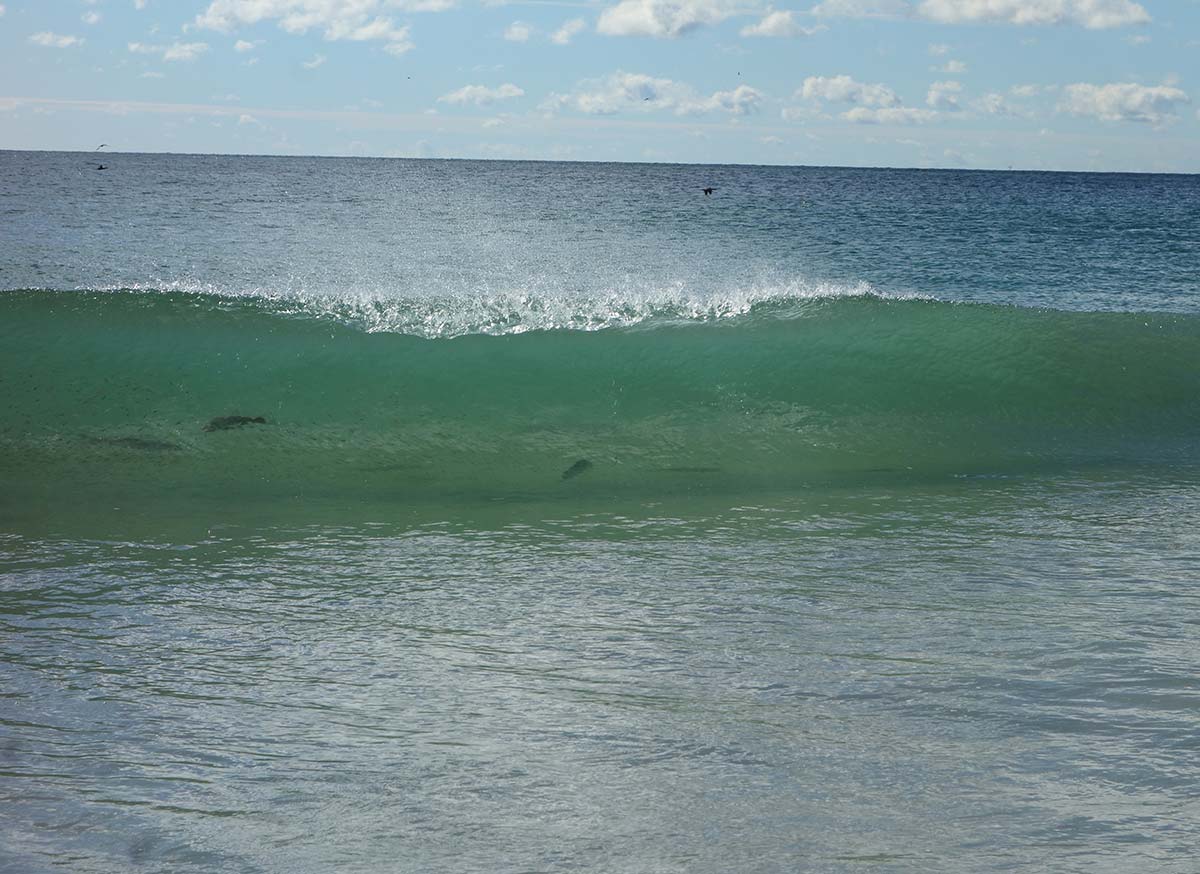
Structure
Striped bass like to travel edges. They follow bottom contours as well as places where rock meets sand or grass meets sand. Edges can also be as simple as a beach lip or bar. Beaches are frequently overlooked in favor of flats but are excellent places to spot and cast to striped bass. Bass will cruise along parallel to a beach or bar, and most often every fish will be traveling the same direction. This makes intercepting them predictable and easy. Rather than moving, a wading angler can stand and wait, and a boat can anchor in position.
On flats, the edges – be they rock, grass, or channel – are only slightly less blatant than a beach lip or bar and are often deep enough that bass will not only travel along them but cross them as well. This may lead to finding travel lanes but it can also improve visibility. When stripers cross from dark eel grass bed over to white sand bottom they stand out like a sore thumb. Such transitions may also warrant spending some time stationary, but wading down them or polling along them is also a good idea.
Another marker that can signify good fishing is a muscle bar. Muscle and oyster bars both provide structure and harbor bait, so it’s no surprise that some of the best sight-fished bass in this angler’s short career came off of muscle bars.
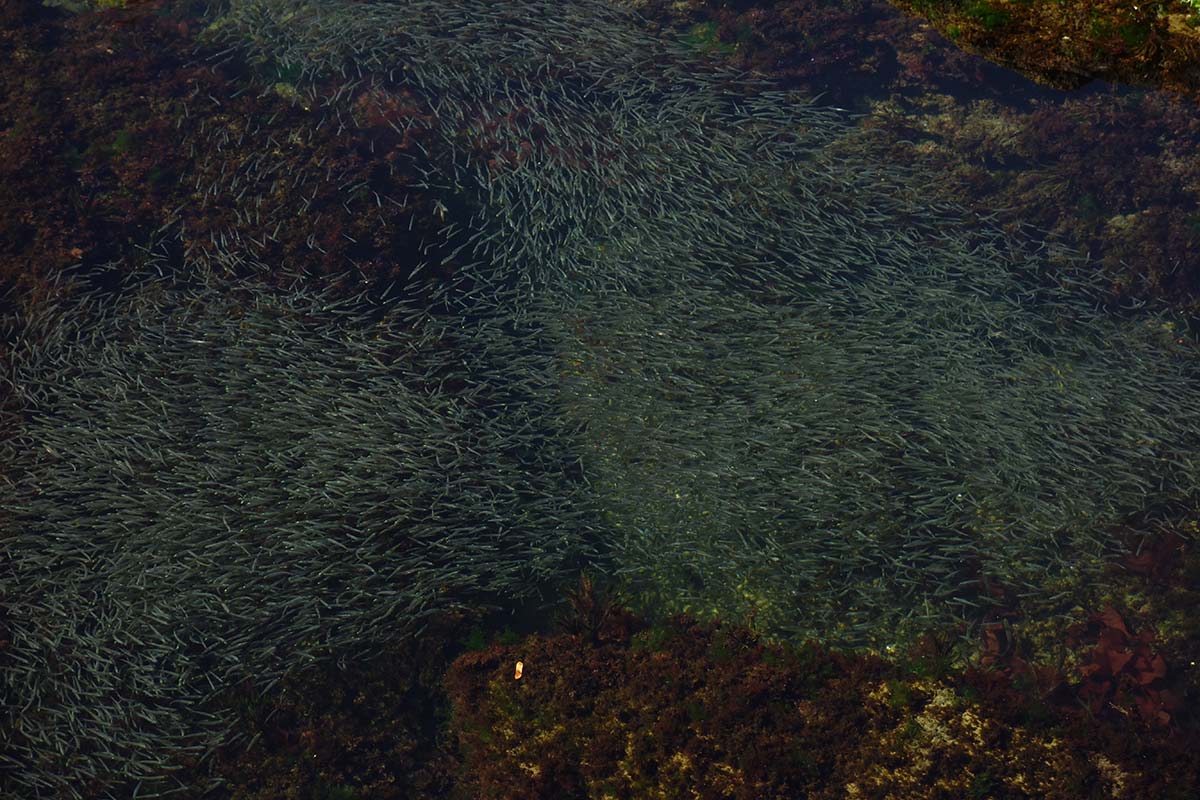
The Good Ol’ Summertime
Finding good structure is just a piece of the equation though. Timing is also key, both seasonal and within the day. For much of the Striper Coast, summer is sight fishing time. Water temperatures in the low 60’s begin to pull bass onto the flats during the day. Like the migration itself, the window moves up the coast in a wave. On Long Island it can begin in the latter half of May. By mid-June, fish have filled in Eastern Connecticut, Rhode Island, and the islands and are working along the Cape. By July there are bass to be sight fished from Boston to Portland. Sight fishing opportunities present themselves as the fish work back south in the fall, but often not in the same classic manner as they do in late spring and summer. Instead of seeking small schools or individual fish stalking flats, the sight fisher out in September or October may find large migrating schools paralleling the beaches.
As for day to day timing, visibility is a concern. If bass are waking or tailing you can sight fish any time there is enough light to see the disturbance. Seeing the fish in the water requires more. Good light through much of the season happens between 10 a.m. and 3 p.m. Sunny and calm days are best. There are outliers though; one of my favorite sight fishing scenarios sets up some fall mornings. Waves breaking on south and east facing beaches will be backlit for the first few hours of the day, silhouetting both bait and striped bass swimming in the breakers. It’s almost magical.
Bass will exhibit different behaviors in sight fishing scenarios that are important to understand. Bass won’t always travel the same direction in relation to the current, sometimes even on the same flat on the same day. Some drift with the tide while others swim into it. Personally I’ve found that bass moving with the current eat better. A possible explanation for that gleaned secondhand and attributed to noted sight-fisher Alan Caolo is that bass swimming with the tide are feeding based on sight while those swimming against the tide are feeding based on smell. This would seem to explain why a bass swimming down tide so happily comes to my unscented fly, but I still cast at fish going both ways.
As with any striper fishing, the fish also favor specific tides. This differs place to place though. A sand flat on Long Island may sight-fish best on a low rise while a mud flat in Maine may fish better around the high. Generally speaking, though, a low rise is a good tide to start with. Many good bites come in the three hours following low tide.
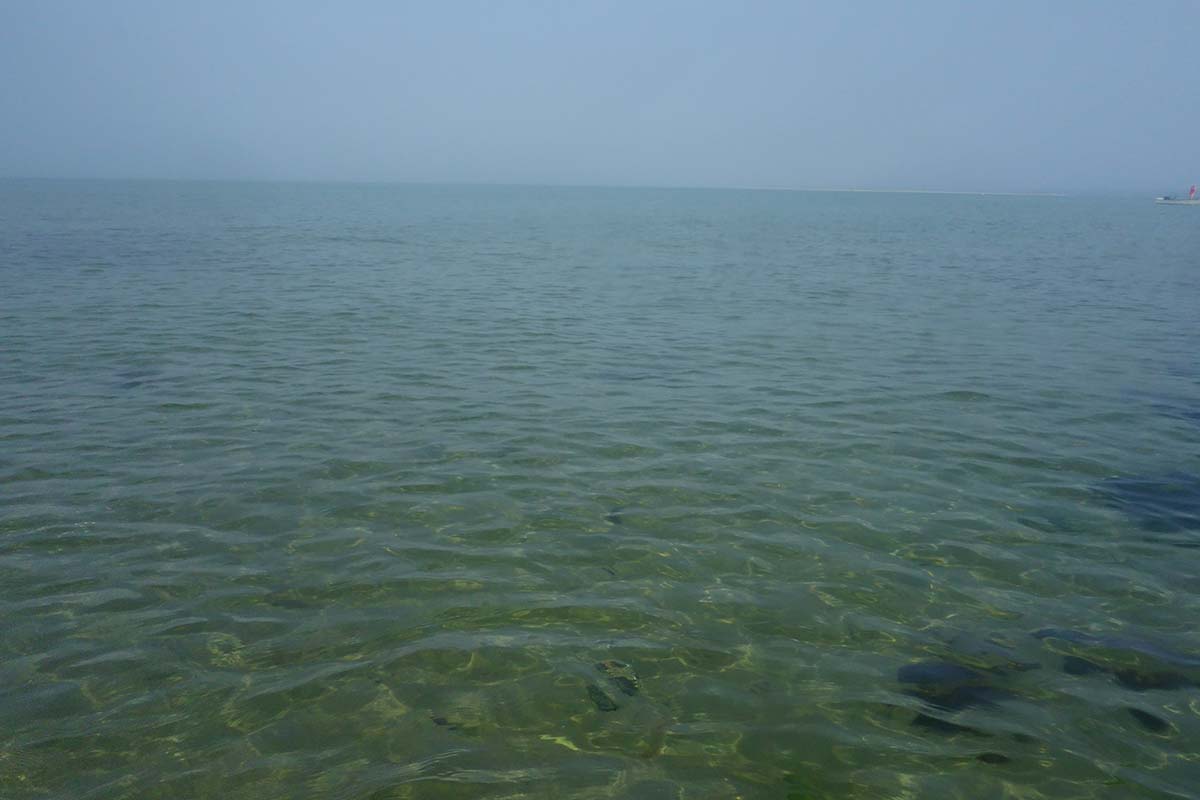
Fly & Spin
Bait is of course also key. Common flats forage includes silversides, sand eels, green crabs, grass shrimp, juvenile flatfish, and sandworms. Most of this is quite small bait which explains why the fly rod is often the favorite tool of striped bass sight fishers. Delicately delivering small, barely weighted, offerings is made all the easier with fly tackle. Rods in the 7 to 9 weight range are best suited for this game, with floating or intermediate lines. Long leaders of 10 to 12 feet tapered down to 15- or 12-pound tippets excel. Being a good caster is imperative for making accurate presentations and delicate landings. Dave Skok’s Strong Arm Merkin, Joe Webster’s Crouser, Eric Peterson’s Synergy Spearing, EZ Body Sand Eels, Jack Gartside’s Gurgler, and Steve Culton’s Grass Shrimp Solution are all necessary flies in the sight fisher’s box.
Don’t leave the spinning rod at home though; it has its place in this fishery as well. Presentations should remain small, with weightless plastics or light jigs doing the bulk of the work. Albie Snax are one of the most efficient sight fishing lures. A twitchy and erratic retrieve often drives striped bass nuts when they are hunting the shallows. Also useful are traditional bonefish jigs and bucktails in the 1/8- to 1/4-ounce range. When allowed to fall in front of a tailing striper, these presentations work as well as any fly.
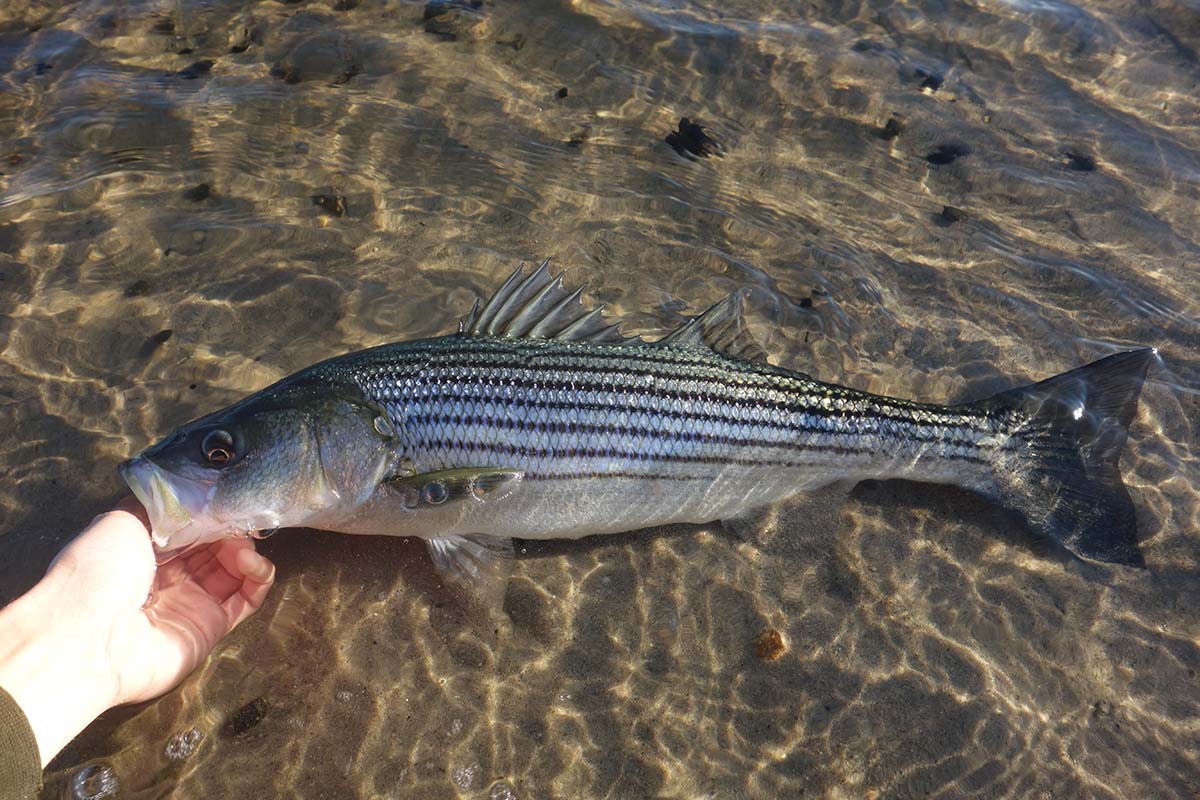
Placement Is Everything
Presentation is as key as lure selection. It’s all too easy to want to land your offering right in front of the fish, but remember that predators aren’t used to seeing their prey essentially attack them. Cast well ahead of and a bit beyond your target, leading the fish by as much as 6 to 10 feet. In clear water a striped bass will have no problem finding the lure or fly, and it should be closing the distance anyway if you’ve led it well. With tailing bass, the presentation needs to be a little closer. These fish are focused on a narrower area. If your lure is going to land loudly, try to cast it beyond the fish and bring it to it. With a fly and floating line, you risk spooking the fish with the line so this won’t work as well. I try to land the fly within a few feet of the fish as delicately as possible.
There are a plethora of little details that come into play when the fish engages with the lure or fly, body language that will tell the fish’s hand. It’s often like a short game of wit to manipulate the lure and get the bass to commit to it. If you were standing on the bow of my canoe casting at a striper, it would be easy to explain; in words on paper…less so. Knowing when to strip or twitch or pause comes with time and experience. But worry not: refusals are part of the game, and it’s a lot more exciting seeing it happen than blind casting and having a bass refuse when you didn’t even know it was there.
Sight fishing may not reliably produce striped bass as big as some other methods but the opportunity is still there. The game takes place in some of the most beautiful environments in the Northeast. Some days it really feels like I’m standing in the Bahamas or on the bow of a skiff in the Keys. The fish can be fickle but anytime a fish is visible it adds a new layer to the experience. Getting to watch them behaving naturally, then responding to your presentation, and maybe if you do everything right, eating it, is an experience that is second to none. The quality of a catch should be measured in the richness of the experience, not merely the size of the fish. A sight fished 30-incher is often a far more exhilarating catch than a cow caught trolling or jigging.
